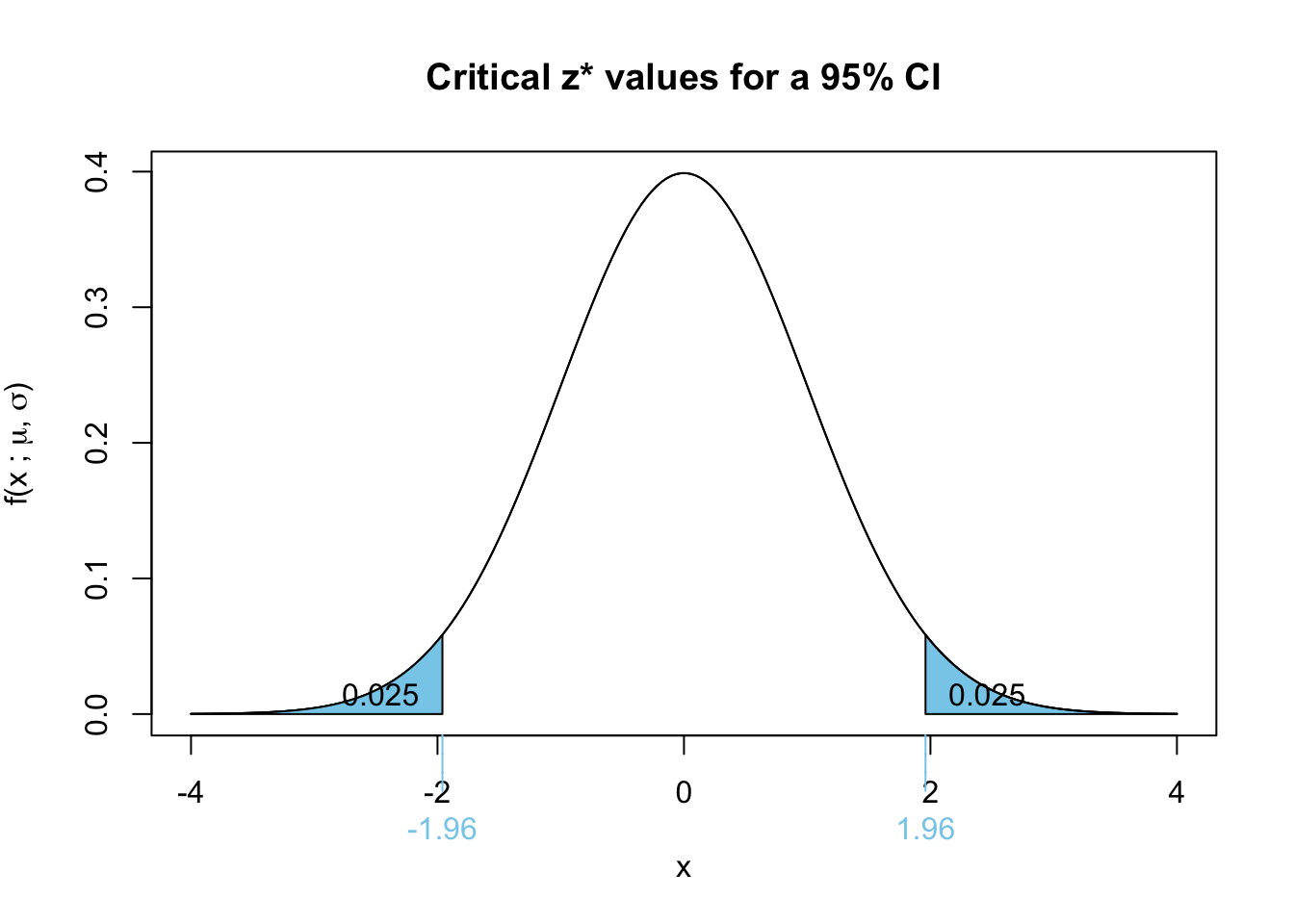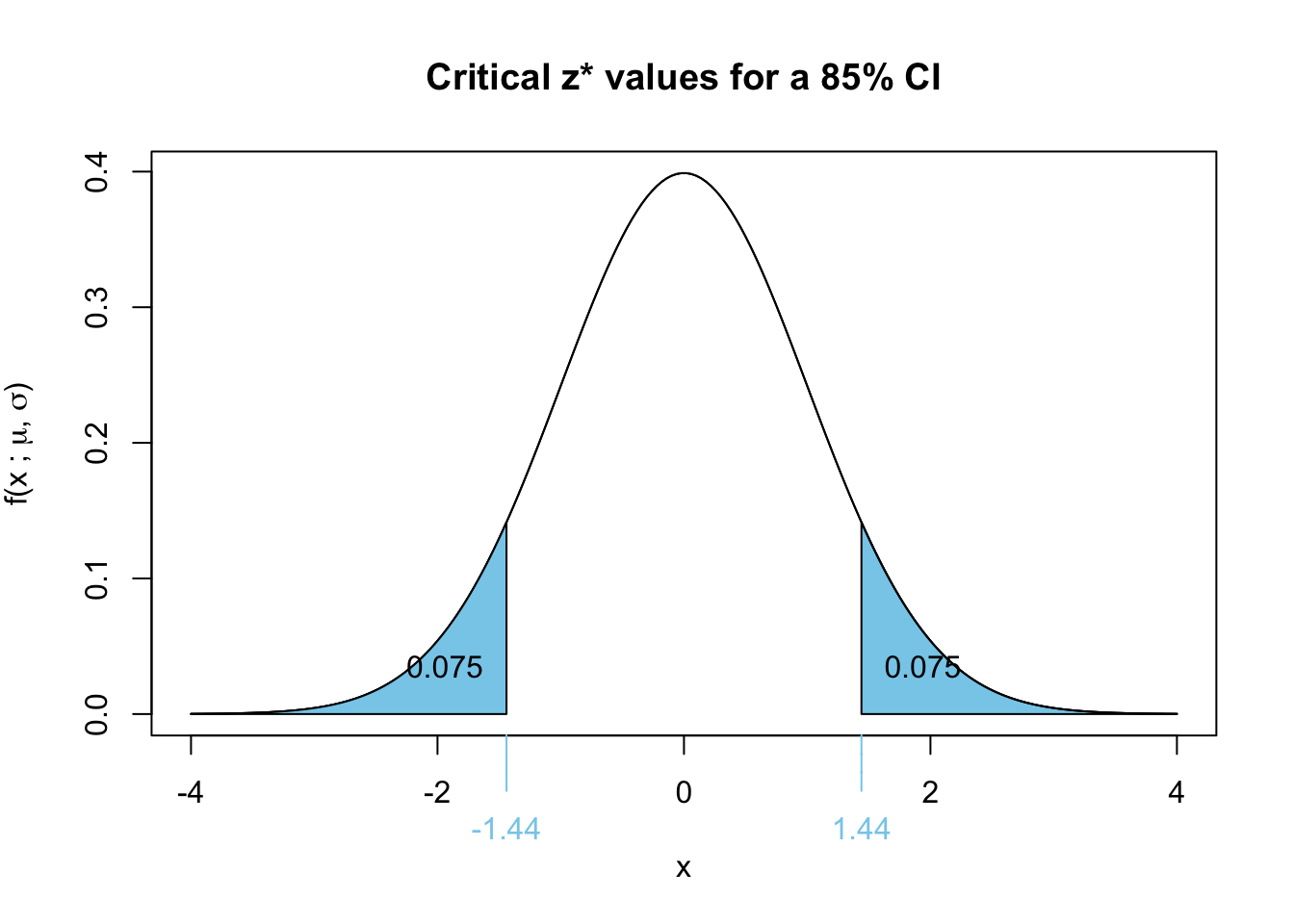round(median(absenteeism$days),2)[1] 11STAT 205: Introduction to Mathematical Statistics
Dr. Irene Vrbik
University of British Columbia Okanagan
Exercise 1.1 What is the extension for quarto documents?
.rmd.qmd.html.r.qrtqmd
Exercise 1.2 What does echo: false do in a Quarto code chunk?
Exercise 1.3 Which of the following is NOT part of the YAML section in a Quarto document?
titleauthoroutputsubtitleExercise 1.4 What is the syntax for producing code chunks in Quarto?
r inside{r} at the start:{r} inside{.r} at the start:Use triple backticks with {r} at the start:
Exercise 1.5 What does echo: false do in a Quarto code chunk?
Displays the output but hides the code
Exercise 1.6 Why is setting a seed important in R, and how do you set one?
Setting a seed ensures reproducibility by making random number generation consistent across runs. In R, you set a seed using set.seed(number), where number is any fixed integer (e.g., set.seed(123)).
Exercise 1.7 Based on the output below, identify which data type x has been coded as.
Exercise 1.8 In the context of variables, which of the following is an example of a categorical variable?
Gender of individuals.
Exercise 1.9 Which measure of central tendency is defined as the middle value when data is ordered?
Median
Exercise 1.10 The Interquartile Range (IQR) measures:
The spread of the middle 50% of the data
Exercise 1.11 What does the breaks argument in the hist function do?
The breaks argument in the hist function determines how data is divided into bins. It can be:
- A single number specifying the approximate number of bins.
- A vector specifying exact breakpoints.
- A function that computes breakpoints dynamically.
More bins result in more bars and smaller bin widths.
Exercise 1.12 Consider Figure Figure 1.1, estimate the median number of absent days.
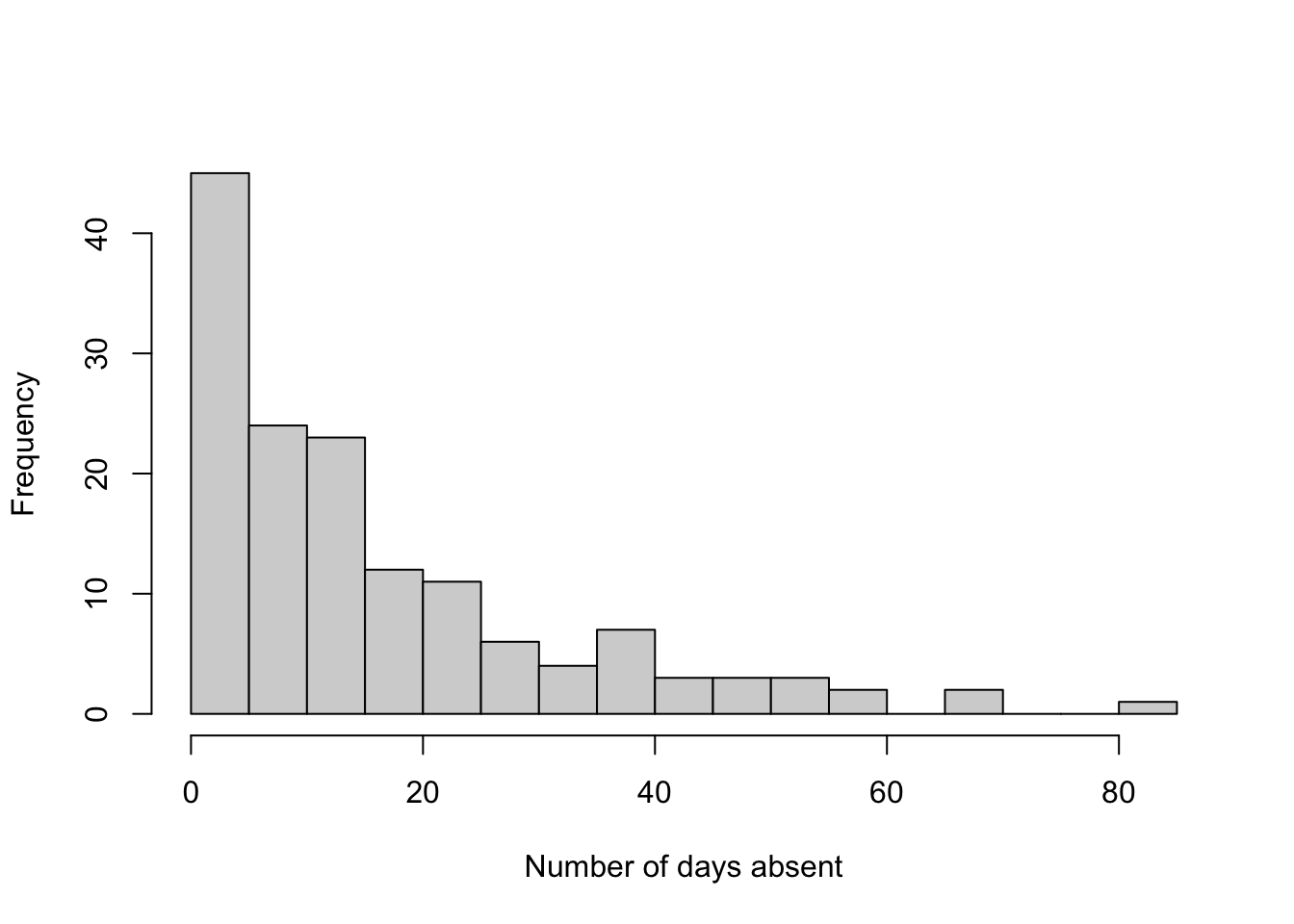

Exercise 1.13 What is the primary difference between descriptive and inferential statistics?
Descriptive statistics summarize data; inferential statistics draw conclusions about a population based on a sample.
Exercise 1.14 In the context of sampling methods, what is a simple random sample?
A sample where each member of the population has an equal chance of being selected.
Exercise 1.15 Explain what selection bias is and provide an example of how it might occur in a research study.
Selection bias occurs when the sample chosen for a study is not representative of the population, leading to biased results. An example is surveying only individuals who have internet access for an online study, which excludes those without internet access.
Exercise 1.16 Which type of study involves observing individuals or groups and collecting data without intervening or manipulating any aspect of the study participants?
Exercise 1.17 Suppose a researcher wants to study the average income of households in Kelowna.
1. All households in Kelowna. 2. Sampling houses only in a rich neighborhood. 3. The population parameter of interest is** \(\mu\), **the average household income in Kelowna.
Exercise 2.1 Which of the following statements best describes statistics?
Exercise 2.2 True or False: Parameters are descriptive measures computed from a sample, while statistics are descriptive measures computed from a population.
False
It’s the other way around parameters are descriptive measures computed from a population, while statistics are descriptive measures computed from a sample.
Exercise 2.3 Let \(X_1,\dots, X_n\) be a random sample from a gamma probability distribution with parameters \(\alpha\) and \(\beta\).
Recall the Probability Density Function (PDF) of the Gamma Distribution:
\[ f(x; \alpha, \beta) = \frac{\beta^\alpha x^{\alpha - 1} e^{-\beta x}}{\Gamma(\alpha)} \]
where \(x > 0\), \(\alpha > 0\) is the shape parameter, \(\beta > 0\) is the rate parameter, and \(\Gamma(\alpha) = \int_0^\infty x^{\alpha - 1} e^{-x} \, dx\) is the gamma function. Find the method of moment (MoM) estimators for the unknown parameters \(\alpha\) and \(\beta\). You may use the results below:
\[\begin{align} \mathbb{E}[X] &= \alpha\beta, & \text{Var}(X) &= \alpha\beta^2 \end{align}\]
Using the method of moments, we equate the population moments to the sample moments:
Setting the first population moment equal to the first sample moment and solving for \(\beta\): \[ \mathbb{E}[X] = \alpha \beta \approx \bar{X} \] \[ \beta = \frac{\bar{X}}{\alpha} \]
The second moment equation (using variance): \[ \text{Var}(X) = \alpha \beta^2 \approx S^2 \] Substituting \(\beta\): \[ \alpha \left(\frac{\bar{X}}{\alpha}\right)^2 = S^2 \] \[ \frac{\bar{X}^2}{\alpha} = S^2 \] Solving for \(\alpha\): \[ \alpha = \frac{\bar{X}^2}{S^2} \]
Substituting \(\alpha\) into the equation for \(\beta\): \[ \beta = \frac{S^2}{\bar{X}} \]
Thus, the moment estimators are:
\[
\hat{\alpha} = \frac{\bar{X}^2}{S^2}, \quad \hat{\beta} = \frac{S^2}{\bar{X}}
\]
Exercise 2.4 Which of the following best describes the concept of sampling distribution?
Exercise 2.5 Let \(X_1, \dots, X_n\) be \(N(\mu, \sigma^2)\).
The likelihood function is:
\[ L (\mu, \theta) = (2\pi\theta)^{-n/2} \exp \left( -\frac{\sum_{i=1}^{n} (x_i - \mu)^2}{2\theta} \right) \]
Taking the log-likelihood:
\[ \ln L (\mu, \theta) = -\frac{n}{2} \ln (2\pi) - \frac{n}{2} \ln \theta - \frac{\sum_{i=1}^{n} (x_i - \mu)^2}{2\theta} \]
When \(\sigma^2 = \sigma_0^2\) is known, we estimate only \(\mu\). Differentiating the log-likelihood with respect to \(\mu\):
\[ \frac{\partial}{\partial \mu} \ln L (\mu, \sigma_0^2) = \frac{2 \sum_{i=1}^{n} (x_i - \mu)}{2\sigma_0^2} = \frac{\sum_{i=1}^{n} (x_i - \mu)}{\sigma_0^2} \]
Setting the derivative to zero and solving for \(\mu\):
\[ \sum_{i=1}^{n} (x_i - \mu) = 0 \]
\[ \sum_{i=1}^{n} x_i = n\mu \quad \Rightarrow \quad \hat{\mu} = \bar{X} \]
Thus, the MLE estimator for \(\mu\) is:
\[
\hat{\mu} = \bar{X}
\]
When \(\mu = \mu_0\) is known, we estimate only \(\sigma^2\). Differentiating the log-likelihood function with respect to \(\theta\):
\[ \frac{\partial}{\partial \theta} \ln L (\mu_0, \theta) = -\frac{n}{2\theta} + \frac{\sum_{i=1}^{n} (x_i - \mu_0)^2}{2\theta^2} \]
Setting the derivative to zero and solving for \(\theta\):
\[
\hat{\sigma}^2 = \frac{\sum_{i=1}^{n} (X_i - \mu_0)^2}{n}
\]
The MLE estimator for \(\mu\) is \(\hat{\mu} = \bar{X}\).
To check if it is unbiased, we compute its expectation:
\[ \mathbb{E}[\hat{\mu}] = \mathbb{E}[\bar{X}] \]
Since \(\bar{X} = \frac{1}{n} \sum_{i=1}^{n} X_i\), and using the linearity of expectation:
\[ \mathbb{E}[\bar{X}] = \frac{1}{n} \sum_{i=1}^{n} \mathbb{E}[X_i] \]
Since \(\mathbb{E}[X_i] = \mu\) for all \(i\):
\[ \mathbb{E}[\bar{X}] = \frac{1}{n} \times n\mu = \mu \]
Since \(\mathbb{E}[\hat{\mu}] = \mu\), we conclude that \(\hat{\mu}\) is an unbiased estimator of \(\mu\).
Exercise 2.6 Let \(\hat{\theta}_1\) be the sample mean and \(\hat{\theta}_2\) be the sample median. It is known that
\[ \text{Var}(\hat{\theta}_2) = (1.2533)^2 \frac{\sigma^2}{n} \]
Find the efficiency of \(\hat{\theta}_2\) relative to \(\hat{\theta}_1\).
The relative efficiency is given by:
\[ \text{eff}(\hat{\theta}_1, \hat{\theta}_2) = \frac{\text{Var}(\hat{\theta}_1)}{\text{Var}(\hat{\theta}_2)} \]
Substituting the given variances:
\[ \text{eff}(\hat{\theta}_1, \hat{\theta}_2) = \frac{\frac{\sigma^2}{n}}{(1.2533)^2 \frac{\sigma^2}{n}} \]
Simplifying:
\[ = \frac{\sigma^2/n}{1.57076 \cdot (\sigma^2/n)} = \frac{1}{1.57076} \approx 0.6366 \]
Thus, the relative efficiency of \(\hat{\theta}_2\) (the sample median) relative to \(\hat{\theta}_1\) (the sample mean) is 0.6366.
Exercise 2.7 Suppose we have a manufacturing process where widgets are produced, and the time it takes for a widget to be completed follows an exponential distribution with a mean time of 4 hours. If thirty-five widgets from this manufacturer are chosen at random:
Let \(X_i\) be the time to complete the \(i\)th widget, which follows an exponential distribution:
\[ X_i \sim Exp(\lambda = \frac{1}{4}) \]
By the Central Limit Theorem, the mean completion time \(\bar{X}\) for \(n = 35\) follows a Normal distribution with:
Mean: \(\mu_{\bar{X}} = 1/0.25\)
Standard Error:
Since the variance of an exponential distribution \(Exp(\lambda)\) is \(\frac{1}{\lambda^2}\), we compute:
\[ \sigma_{\bar{X}} = \frac{1/\lambda}{\sqrt{n}} = \frac{4}{\sqrt{35}} \approx 0.6761234 \]
Thus, we have:
\[
\bar{X} \sim \text{Normal}(\mu_{\bar X} = 4, \sigma_{\bar X} = 0.676)
\]
or we can keep it in fraction form:
\[ \bar{X} \sim \text{Normal}(\mu_{\bar X} = 4, \sigma_{\bar X} = \frac{4}{\sqrt{35}}) \]
We compute:
\[ \Pr(\bar{X} > 5) = \Pr \left( Z > \frac{5 - \mu_{\bar{X}}}{\sigma_{\bar{X}}} \right) \]
Substituting values:
\[ \Pr \left( Z > \frac{5 - 4}{4/\sqrt{35}} \right) \]
\[ = \Pr(Z > 1.4790199) \]
Using standard normal tables:
\[\begin{align*} \Pr(Z > 1.479) &= 1 - \Pr(Z \leq 1.479)\\ &= 1 - \Pr(Z \leq 1.479)\\ &= 1 - 0.9304\\ &\approx 0.0696\\ \end{align*}\]
Thus, the probability that the mean failure time exceeds 5 hours is 0.0696.
A graphical representation is shown below:

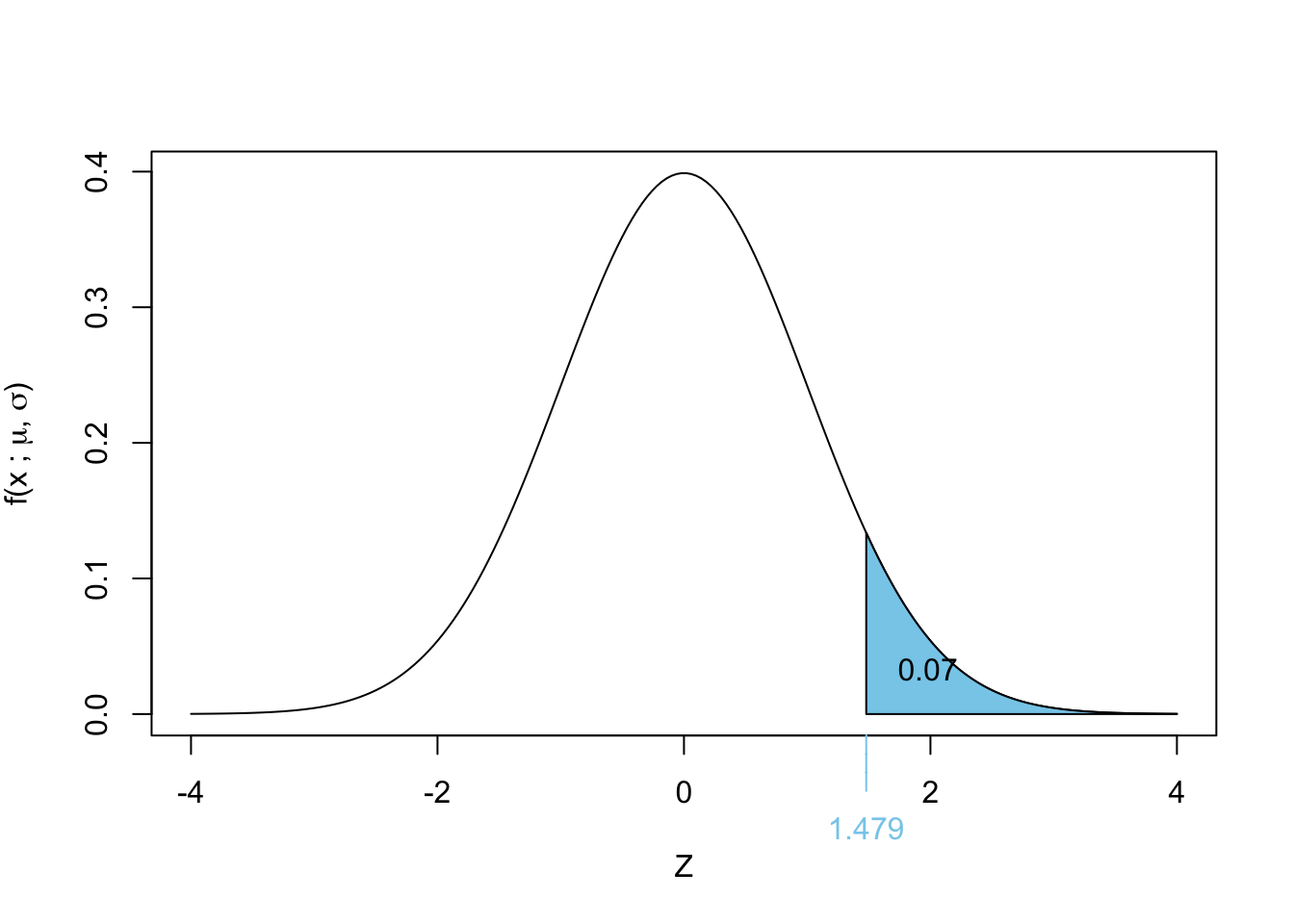
Exercise 2.8 Let \(X_1, X_2, \dots, X_5\) be a random sample from a normal distribution with mean 55 and variance 223. Let
\[ Y = \sum_{i=1}^{5} \frac{(X_i - \bar{X})^2}{223} \]
Using the result that if \(X_i \sim N(\mu, \sigma^2)\), then:
\[Y = \sum_{i = 1}^n\frac{(X_i - \bar{X})^2}{\sigma^2} \sim \chi^2_{n-1}\]
In this case:
\[ Y = \sum_{i=1}^{5} \frac{(X_i - \bar{X})^2}{223} \sim \chi^2_{4} \]
\[\begin{align*}
\Pr(Y \leq 2)
&= \Pr(\chi^2_4 \leq 2) \\
&= 1 - \Pr(\chi^2_4 \geq 2) \\
&= 1 - 0.2642411 \\
&= 0.2642411
\end{align*}\]

How would you calculate this probability in R?
pchisq(2, df = n-1, lower.tail = FALSE)qchisq(2, df = n-1, lower.tail = FALSE)pchisq(2, df = n-1)pchisq(1-2, df = n-1)\[\begin{align*}
\Pr(2 \leq Y \leq 4)
&= \Pr(Y \leq 4) - \Pr(Y \leq 2) \\
&= \Pr(\chi^2_4 \leq 4) - \Pr(\chi^2_4 \leq 2) \\
&= \Pr(\chi^2_4 \geq 2) - \Pr(\chi^2_4 \geq 4) \\
&= 0.7357589 - 0.4060058\\
&= 0.329753 \approx 0.33
\end{align*}\]

Exercise 3.1 Which of the following best describes the purpose of a confidence interval?
Exercise 3.2 As part of an investigation from Union Carbide Corporation, the following data represent naturally occurring amounts of sulfate S04 (in parts per million) in well water. The data is from a random sample of 24 water wells in Northwest Texas.
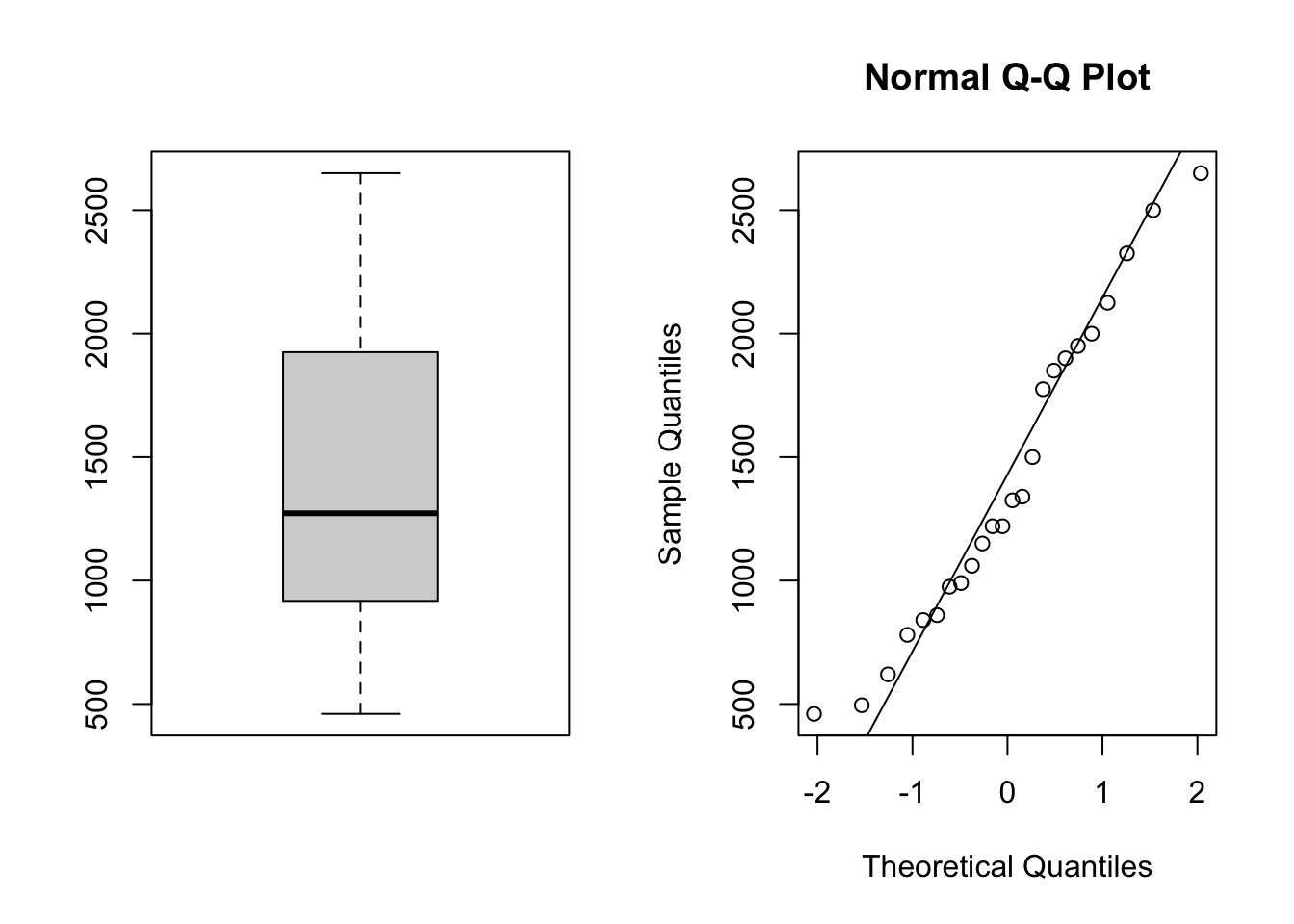
No, there is no indication of a violation of the normality assumption. The boxplot appears roughly symmetric, and there is no systematic curvature or evident outliers in the normal QQ plot.
Based on the following summary statistics, estimate the standard error for \(\bar{X}\) (assume that the 24 observations are stored in a vector called data)
\[ \sigma_{\bar X} = \text{StError}(\bar X) = \frac{\sigma}{\sqrt{n}} \]
Since we don’t have \(\sigma\) we will estimate this using:
\[ \hat \sigma_{\bar X} = \frac{s}{\sqrt{n}} = \frac{636.4592}{\sqrt{24}} = 129.9166902 \approx 129.917 \]
Using the \(t\)-table with \(n - 1 = 23\) degrees of freedom we want:
\[\begin{align*} \Pr(t_{23} > t^*) &= 0.05\\ \implies t^* &= 1.714 \end{align*}\]
The 90% confidence interval for \(\mu\) is computed using
\[\begin{align*} \bar x &\pm t^* \sigma_{\bar X}\\ 1412.9167 &\pm 1.714 \times 129.917\\ 1412.9167 &\pm 222.677738\\ (1190.239 &,1635.594 ) \end{align*}\] In words, we are 90% confident that the average sulfate S04 in well water is between 1190.2 and 1635.6 in parts per million.
Exercise 3.3 In New York City on October 23rd, 2014, a doctor who had recently been treating Ebola patients in Guinea went to the hospital with a slight fever and was subsequently diagnosed with Ebola. Soon thereafter, an NBC 4 New York/The Wall Street Journal/Marist Poll found that 82% of New Yorkers favored a “mandatory 21-day quarantine for anyone who has come into contact with an Ebola patient.” This poll included responses from 1042 New York adults between October 26th and 28th, 2014.
The point estimate, based on a sample size of \(n = 1042\), is \(\hat{p} = 0.82\).
To check whether \(\hat{p}\) can be reasonably modeled using a normal distribution, we check:
Since both conditions are met, we can assume the sampling distribution of \(\hat{p}\) follows an approxiamte normal distribution.
The standard error is given by:
\[ SE_{\hat{p}} = \sqrt{\frac{\hat{p}(1-\hat{p})}{n}} \]
Substituting values:
\[
SE_{\hat{p}} = \sqrt{\frac{0.82(1 - 0.82)}{1042}} = \sqrt{\frac{0.82 \times 0.18}{1042}} \approx 0.012
\]
Using \(SE = 0.012\), \(\hat{p} = 0.82\), and the critical value \(z^* = 1.96\) for a 95% confidence level:
\[\begin{align*} \text{Confidence Interval} &= \hat{p} \pm z^* \times SE \\ &= 0.82 \pm 1.96 \times 0.012 \\ &= 0.82 \pm 0.02352 &\text{ans option 1}\\ &= (0.797, 0.843)&\text{ans option 2} \end{align*}\]
Either the point estimate plus/minus the margin of error, or the confidence interval are acceptable final answers.
We are 95% confident that the proportion of New York adults in October 2014 who supported a quarantine for anyone who had come into contact with an Ebola patient was between 0.797 and 0.843.
narrower
A lower confidence level corresponds to a smaller \(z^*\) value, which results in a narrower confidence interval.
